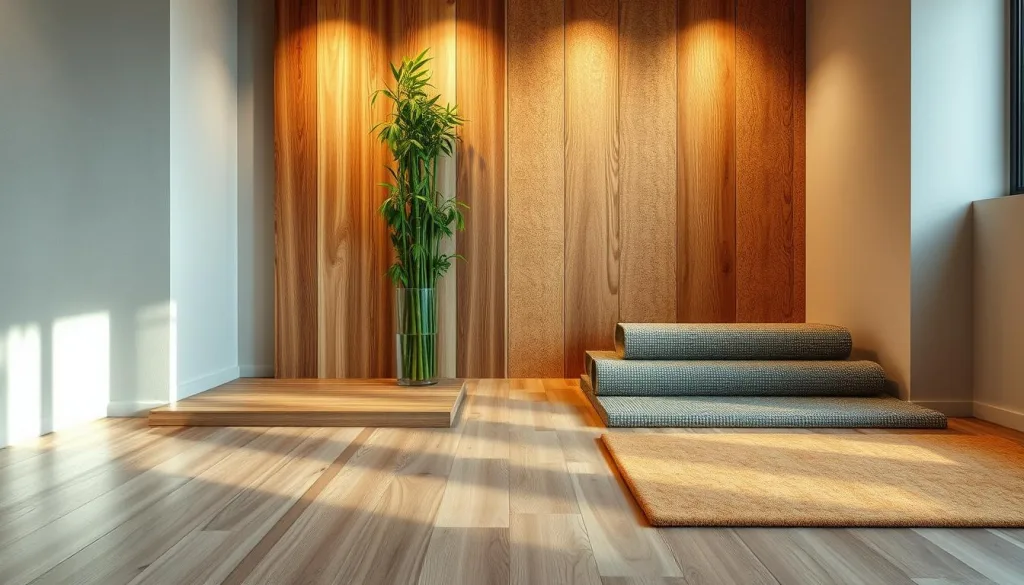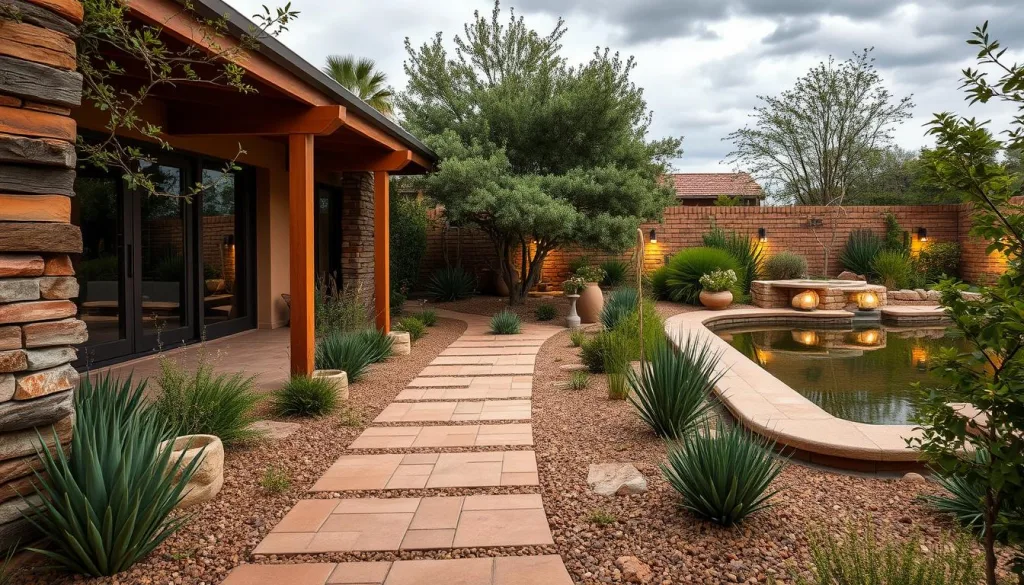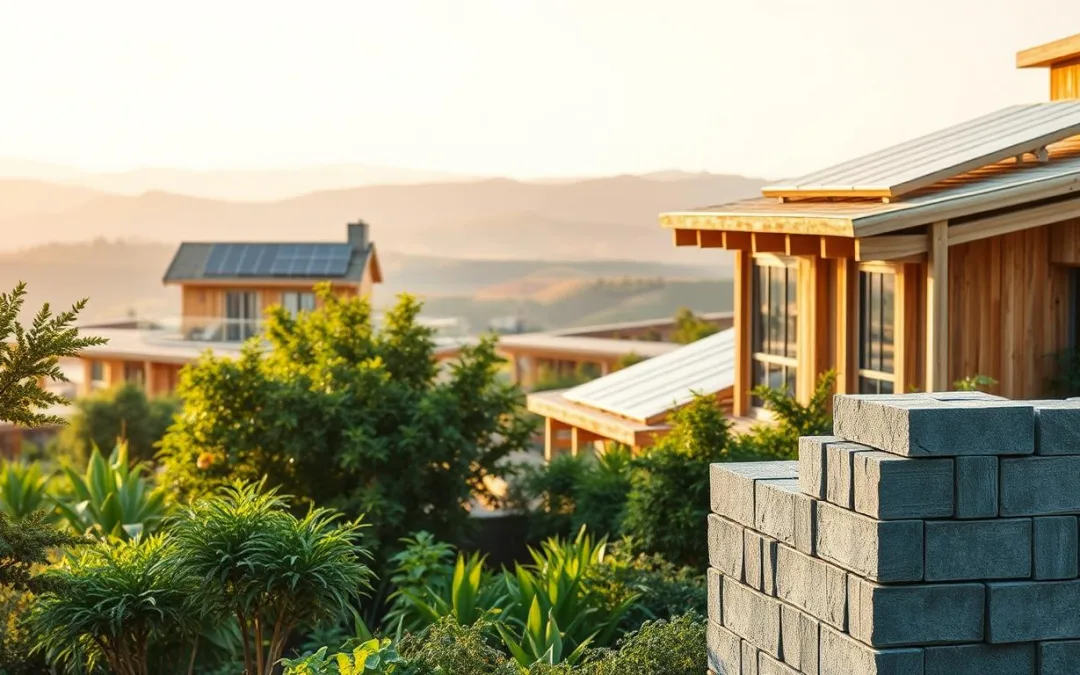Sustainable construction materials are changing how we build and renovate homes. As we become more aware of the environment, we look for materials that are good for the planet. These materials help make our homes healthier and reduce our carbon footprint.
The construction world is moving towards greener practices. Eco-friendly materials cut down on environmental harm. They also make homes more energy-efficient, durable, and cost-effective in the long run.
Using sustainable materials is not just a trend. It’s a smart choice for designing modern homes. These materials help save natural resources, cut down on waste, and make our homes stronger.
Key Takeaways
- Sustainable materials reduce environmental impact significantly
- Eco-friendly building materials can lower energy costs
- Green construction supports resource conservation
- Sustainable materials improve indoor air quality
- Innovative materials enhance home durability
Understanding the Impact of Sustainable Construction Materials
Green building supplies are changing the construction world. They offer products that are good for the environment. This shift is making buildings more efficient and responsible.
Sustainability in construction is more than just choosing materials. It’s about building in a way that’s good for the planet, our wallets, and people. New building solutions are cutting down on carbon emissions and using fewer resources.
Environmental Benefits of Green Building
The benefits of sustainable construction are huge. Here are some key points:
- Can cut global carbon emissions by up to 30% over a building’s life
- Uses less waste with recycled and renewable materials
- Reduces demolition waste by 25-30%
Cost-Effectiveness and Long-Term Savings
Green building products save money too. Recycled materials can be 30% cheaper than new ones. This means big savings for construction projects.
| Material Type | Cost Savings | Energy Efficiency |
|---|---|---|
| Recycled Wood | 30% cheaper | 15-20% better insulation |
| Recycled Steel | 25-30% lower cost | Reduced embodied carbon |
| Low-VOC Materials | Comparable pricing | 50% reduction in chemical emissions |
Reducing Carbon Footprint in Construction
Sustainable materials are key to reducing construction’s environmental impact. Traditional materials cause 23% of global emissions. Switching to green can cut carbon footprints a lot.
The demand for sustainable building materials is growing fast. It’s expected to rise by 10% each year. By choosing green products, we can build structures that help our planet.
Natural and Renewable Building Solutions
The construction world is changing fast. It’s now using eco-friendly materials instead of old ones. These green materials are changing how we build and care for the environment.
New natural materials are bringing big changes for those who care about the planet. They help cut down on carbon emissions and last a long time.
Bamboo: The Fast-Growing Alternative
Bamboo is a top choice for green building. It has amazing qualities:
- Grows up to 3 feet in a single day
- Extremely strong and flexible
- Renewable harvest cycle
- Superior strength-to-weight ratio
Cork: Sustainable Insulation Choice
Cork is a great pick for green building. It has special benefits:
| Property | Cork Advantage |
|---|---|
| Harvesting Method | Bark removal without damaging trees |
| Annual Production | Up to 50 pounds per tree |
| Environmental Impact | Continuous CO2 absorption |
Hemp-Based Construction Products
Hempcrete is a game-changer for green building. It’s a carbon-negative material that absorbs more CO2 than it produces. It’s an exceptional eco-conscious building material.
Using these natural and renewable options, builders can make a big difference. They can build structures that are both sustainable and perform well.
Eco-Friendly Building Materials for Modern Homes
Today, more homeowners choose sustainable building supplies. These options are good for the planet and stylish. The world of eco-friendly construction has changed a lot. Now, we have new materials that are different from the old ways.
Mycelium is a game-changer in sustainable building. It’s made from fungi and is amazing when dry. It’s:
- Water resistant
- Mold proof
- Fire resistant
- Completely compostable
Insulation materials have also improved a lot. Now, they work better and are kinder to the environment.
Here’s a look at some top sustainable building materials for homes:
| Material | Sustainability Factor | Cost per Sq. Ft. |
|---|---|---|
| Recycled Steel | 75% less energy to produce | $1.50 – $5.00 |
| Bamboo | Harvested in 3-5 years | $3.00 – $8.00 |
| Hempcrete | Carbon negative | $4.00 – $10.00 |
Architects and builders are now using these green materials. They see how they can make homes that are good for the planet and look great. The future of building is about materials that are strong and also help our planet.
Recycled Materials Revolutionizing Construction
The construction world is changing fast. Now, we’re using recycled materials more. These materials help cut down waste and harm to the environment. They turn old waste into new, useful things, changing how we build.
In 2018, the EPA said 600 million tons of Construction and Demolition (C&D) waste was made in the US. This shows we really need new ways to recycle in building.
Reclaimed Wood Applications
Reclaimed wood is great for green builders:
- It helps save trees
- It adds a special look
- It cuts down landfill waste
- It keeps old buildings’ charm
Recycled Steel and Metal Products
Steel is a big win for the environment. Making steel now uses 60% less energy than it did 50 years ago. So, using recycled steel is good for our planet.
| Material | Lifespan | Environmental Impact |
|---|---|---|
| Traditional Steel | Unlimited recycling | High carbon emissions at start |
| Recycled Steel | Just as strong as new steel | Way less carbon footprint |
Repurposed Glass in Construction
Waste glass is getting a new life in building. Recycled glass can replace sand and gravel in cement. This makes cement better for the planet.
“One person’s waste is another’s building material” – Sustainable Construction Principle
Using these recycled materials, builders can make a big difference. They can build strong, new structures while protecting our environment.
Innovative Green Insulation Options
Looking into green building supplies has changed how we insulate homes. Now, we have eco-friendly insulation that’s better than old methods. It keeps homes warm in winter and cool in summer.
Today’s green insulation is top-notch in many ways:
- It keeps temperatures just right
- It’s good for the planet
- It saves a lot of energy
- It’s made from natural, renewable sources
Some eco-friendly insulation materials are leading the way in building:
- SteicoFlex Wood Fiber Insulation: It’s made from wood that grows back fast, cutting down on carbon emissions.
- EKOLUTION Hemp Fibre Insulation: It’s made from hemp, a plant that grows quickly and can be used again.
- Cosywool Sheep’s Wool Insulation: It’s a natural product that doesn’t use a lot of energy to make.
Materials like Thermablok Aerogel Insulation Blanket are very efficient. They’re light but keep heat in well. Some green insulation has an R-value of 3.2 to 10.3 per inch.
Choosing green building supplies has big benefits. These materials use less energy and help make our homes more eco-friendly.
Sustainable Flooring and Wall Materials
Building an eco-friendly home begins with choosing the right materials. These should look good, last long, and be kind to the planet. Today, there are many options for floors and walls that are both stylish and green.

New products have changed how we design homes. They let us make spaces that are both beautiful and good for the earth.
Terrazzo: Recycled Artistry in Flooring
Terrazzo is a top pick for green building. It’s made from:
- Recycled marble fragments
- Granite chips
- Quartz pieces
- Repurposed glass elements
It comes from Italy, where it’s been around for over 500 years. Terrazzo turns old materials into gorgeous, lasting floors that are easy on the planet.
Natural Stone Solutions
Natural stone is a great choice for green building. It’s strong and looks good forever. The way it’s mined is careful to protect the environment, making it a lasting part of buildings.
Eco-Certified Wood Products
Wood floors that are good for the planet are another smart pick. Forest Stewardship Council (FSC) certified wood means it’s harvested right. This means:
- Timber is taken responsibly
- Forests are kept healthy
- Local communities benefit
Choosing green floors and walls lets homeowners make lovely homes. They also help protect our planet.
Energy-Efficient Windows and Doors
Changing your home’s energy use starts with the right windows and doors. Using eco-friendly materials is key to a green home. It cuts down on environmental harm and lowers your bills.
Energy-efficient windows are a wise choice for a green home. New technologies have improved window design. This gives homeowners many ways to make their homes more sustainable:
- Fiberglass windows with top-notch thermal performance
- uPVC windows lasting 20-30 years
- Composite windows from recycled materials
- Low-emissivity (Low-E) glass coatings
The savings are big. Energy-efficient windows can cut down on heating and cooling costs a lot. Homes could save over $2,000 a year on energy bills.
| Window Material | Energy Efficiency | Lifespan |
|---|---|---|
| Fiberglass | Excellent thermal barrier | 25-40 years |
| uPVC | Superior insulation | 20-30 years |
| Composite | Recycled material options | 30-50 years |
“Investing in energy-efficient windows is not just an environmental choice, but a smart financial decision,” says sustainable design expert Rachel Green.
Homeowners might get tax breaks and incentives for green windows. With buildings using nearly 70% of the U.S. electricity, every upgrade counts.
Exterior Sustainable Solutions
Sustainable materials are changing how we design home exteriors. The building industry is a big source of CO2 emissions. Homeowners want eco-friendly materials that are good for the planet and look great.
Green Roofing Systems: Nature Meets Architecture
Green roofs are a new way to design sustainably. They add insulation, manage water, and help wildlife. They also cool buildings and improve air quality.
- Reduces building temperature by up to 40%
- Extends roof lifespan by protecting underlying materials
- Provides natural sound insulation
Eco-Friendly Siding Options
There are many siding choices that are both strong and green. Fiber cement, reclaimed wood, and recycled metal are good for the planet and protect your home.
| Material | Sustainability Rating | Durability |
|---|---|---|
| Reclaimed Wood | High | 25-30 years |
| Recycled Metal | Very High | 50+ years |
| Fiber Cement | Medium | 30-50 years |
Sustainable Landscaping Materials
Choosing the right materials for your outdoor space is key. Use permeable pavers, recycled mulch, and native plants to save water and support local life.

By choosing eco-friendly materials, homeowners can make beautiful, lasting exteriors that help the environment and their community.
Future Trends in Sustainable Building Materials
The construction world is changing fast with new, eco-friendly building products. These products are set to change how we build green. New technologies are making it easier to tackle big environmental problems.
Several cutting-edge materials are poised to reshape construction practices:
- Mycelium-based materials offer fully biodegradable alternatives for building components
- Carbon-negative concrete captures more CO2 than it emits during production
- Transparent solar panels enable electricity generation while maintaining natural light
- Graphene composites provide lightweight and durable construction solutions
The future of building looks bright, with new ways to cut down on carbon emissions. For example, phase-change materials could make buildings more energy-efficient. By 2025, 3D-printed building parts might become common, reducing waste and improving precision.
Investors are also getting on board with green building. A Morgan Stanley survey found 85% of U.S. investors want to invest in sustainable projects. This shows a big demand for green building tech.
By 2030, buildings are projected to dramatically reduce their carbon emissions through innovative material technologies.
As the construction world keeps growing, these green products will be key. They will help build structures that are better for the planet and work well. This is a big step towards a more sustainable future.
Conclusion
The construction industry is at a turning point, moving towards eco-friendly building materials. Sustainable materials are now essential in building design and development. This shift helps reduce environmental impact and makes buildings more resilient.
Using eco-friendly materials brings many benefits, not just for the planet. Homeowners and developers save money in the long run. They also help create a sustainable future. Materials like recycled steel and renewable bamboo show that green choices can be effective and environmentally friendly.
Looking forward, using sustainable materials is vital for tackling climate issues. Education, new technologies, and regulations will help change the building industry. Every project with green materials cuts down on carbon emissions and makes homes healthier.
Our dedication to sustainable materials can change building design. By choosing eco-friendly options, we build structures that protect our planet. These buildings also offer better performance and value for years to come.
FAQ
What are the main benefits of using eco-friendly building materials?
How do sustainable building materials compare in cost to traditional materials?
Are eco-friendly building materials as durable as traditional construction materials?
Can sustainable building materials be used in all types of construction projects?
How do green building materials contribute to energy efficiency?
What certifications should I look for when choosing sustainable building materials?
Are there eco-friendly options for home exterior materials?
How can I incorporate sustainable materials into an existing home?
Source Links
- Top Sustainable Building Materials for Creating Eco-Friendly Homes – https://www.unitedroofing.ai/news/sustainable-building-materials-for-eco-friendly-homes
- Sustainable Construction Materials: A Guide for Construction Managers – https://mrinetwork.com/hiring-talent-strategy/sustainable-construction-materials-a-guide-for-construction-managers/
- 10 sustainable building – https://ccemagazine.com/news/10-sustainable-building-materials/
- Unlocking the Advantages of Recycled and Renewable Building Materials | Environmental Construction Solutions – https://ecsproductsva.com/blog/benefits-of-recycled-and-renewable-building-materials
- What are the best materials for sustainable construction and renovation? – https://www.cleanenergywire.org/factsheets/what-are-best-materials-sustainable-construction-and-renovation
- Sustainable Building Solutions | Green City Times – https://www.greencitytimes.com/sustainable-building-solutions/
- Green Building Supply, Safe, Non Toxic, Environmentally Friendly Materials – https://www.greenbuildingsupply.com/
- Innovative Eco-Friendly Building Materials: Trends and Future Prospects – Bafuture – https://www.bafuture.org/blog/innovative-eco-friendly-building-materials-trends-and-future-prospects/
- Top 10 Sustainable Building Materials for Modern Homes – https://modernhb.com/news/top-10-sustainable-building-materials-for-modern-homes/
- Explore Top Eco-Friendly Building Materials for Houses in 2024 – https://www.constructelements.com/post/types-of-eco-friendly-building-materials-for-houses
- 10 Eco Building Materials Revolutionizing Home Construction – https://elemental.green/10-eco-building-materials-revolutionizing-home-construction/
- Revolutionizing Construction: Sustainable Materials for Tomorrow’s World – https://hwpartstore.com/blogs/news/sustainable-materials-for-tomorrow-world?srsltid=AfmBOophe2VFF4H0G39LpQjgD95NFQEvcMV7_0iHPsyXwJtDDwJPur6T
- 15 Sustainable Construction Materials – https://www.truegridpaver.com/sustainable-construction-materials/?srsltid=AfmBOor6y1VjF17EyC-c_o4IdKi8-GOH7gOA8wmxxe82vSqOS9Cc3MGw
- 8 Insulation Products that Help Reduce Climate Impact – 2050 Materials – https://2050-materials.com/blog/8-insulation-products-with-sustainable-properties-for-a-greener-future/
- The Top Eco-Friendly Insulation Materials – Thermtest – https://thermtest.com/the-top-eco-friendly-insulation-materials
- Top 10 Green Building Materials for Sustainable Construction – https://www.clarisdesignbuild.com/top-10-green-building-materials-for-sustainable-construction/
- Top 15 Sustainable Building Materials for an Eco-Friendly Future – https://blog.enscape3d.com/top-sustainable-building-materials
- Sustainable Flooring | Non-Toxic, Durable, Affordable – https://www.greenbuildingsupply.com/All-Products/Sustainable-Flooring
- Top 5 Sustainable Window Materials – Energy Window Solutions Dallas & Fort Worth Area – https://energywindowsolutions.com/5-sustainable-window-materials/
- Building Green: Improving Energy Efficiency in Your Home – Clyde Companies Inc. – https://www.clydeinc.com/building-green-improving-energy-efficiency-in-your-home/
- Top 11 Sustainable Building Materials for a Greener Future in 2025 – https://www.novatr.com/blog/sustainable-building-materials
- The 10 Best Sustainable Building Materials | Cemex Ventures – https://www.cemexventures.com/sustainable-building-materials/
- 12 Sustainable & Eco-Friendly Building Materials Used In Construction – https://buildpartner.com/12-sustainable-eco-friendly-building-materials-used-in-construction/
- The Future of Construction Materials: Trends to Watch in 2025 – https://cmsmaterialsolutions.com/blogs/news/the-future-of-construction-materials-trends-to-watch-in-2025
- The future of green construction materials – https://blueprintforbetter.org/articles/the-future-of-green-construction-materials/
- A Comprehensive Guide for the Construction Industry – Coastal Custom Products – https://coastalcustomproducts.com/the-rise-of-eco-friendly-building-materials-a-comprehensive-guide-for-the-construction-industry/
- Building a Better World: Green Building Materials Benefit Environment – https://www.mataverdedecking.com/blog/building-a-better-world-how-green-building-materials-benefit-the-environment
- Benefits of Using Eco friendly Building Materials | BOI – https://buildoninfra.com/benefits-of-using-eco-friendly-building-materials/


